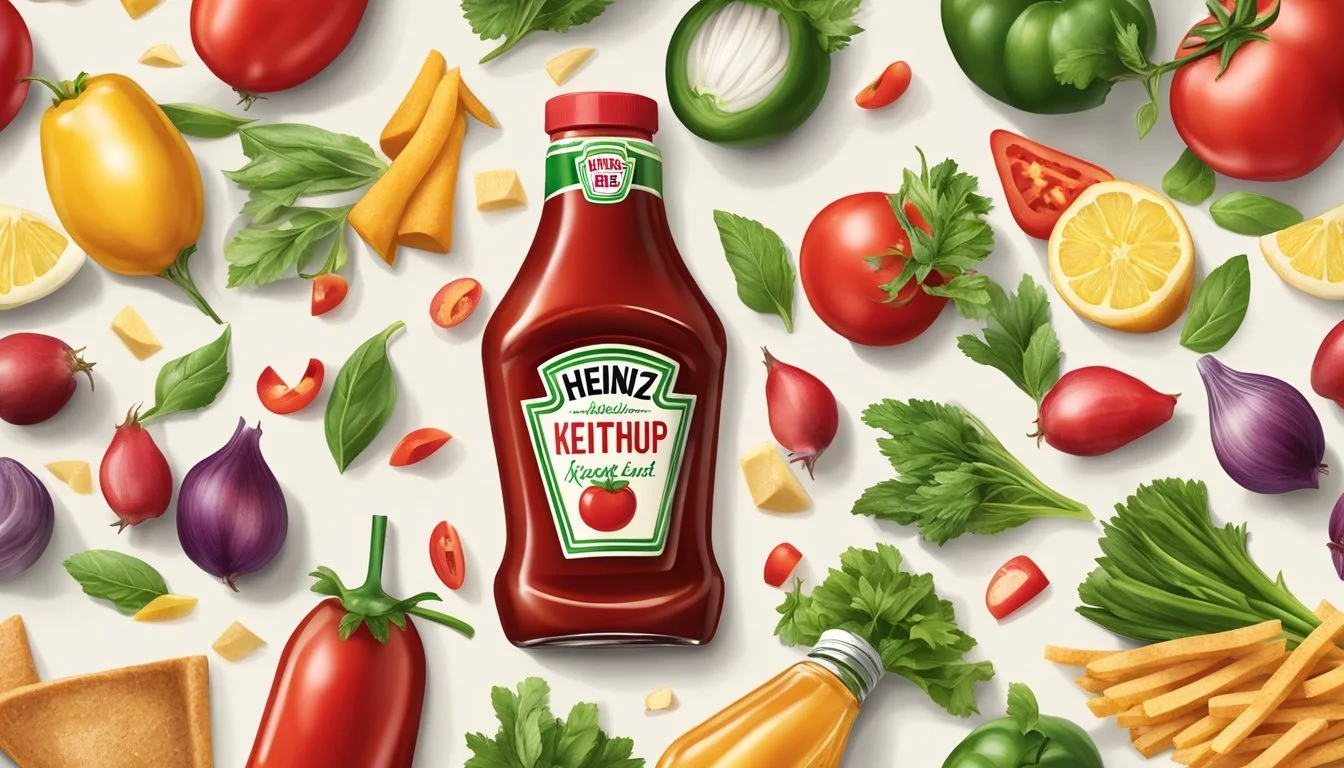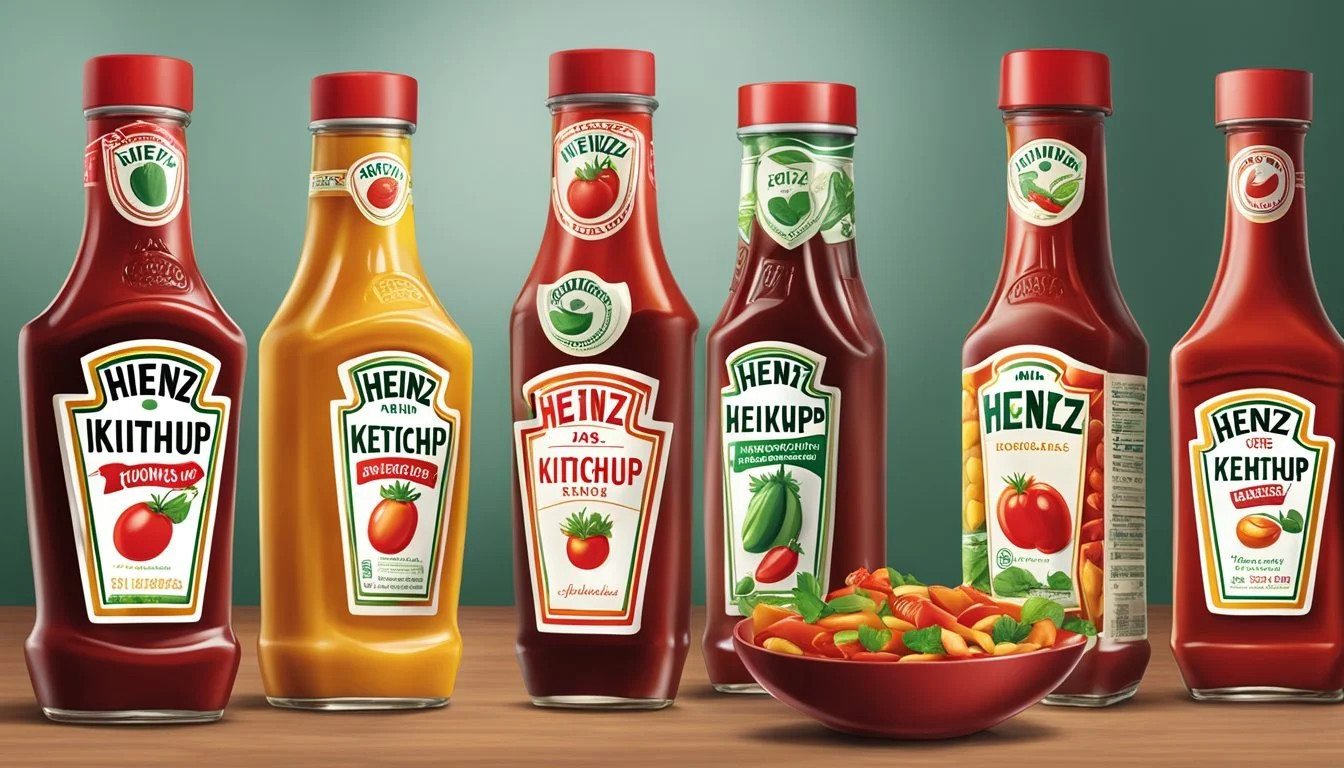Heinz Ketchup Recipes for Every Occasion
Culinary Creations to Savor
Heinz Ketchup stands as a culinary icon, its ubiquitous presence in diners and on family tables a testament to its beloved status. There's a certain nostalgia attached to the rich, tangy taste that complements a wide array of dishes, from the classic burger and fries to a more gourmet culinary creation. For enthusiasts looking to recreate or remix the classic Heinz flavor at home, there is a treasure trove of recipes that capture the essence of Heinz while allowing for personalization.
Cooking aficionados have devised an array of recipes that bring the essence of Heinz ketchup into the home kitchen, lending its distinctive taste to homemade condiments and meals alike. These recipes cater to a variety of occasions, ensuring that the familiar taste of Heinz can grace the table in new, innovative ways. Whether it's for a family barbecue, a solo snack, or a large gathering, these recipes offer a way to infuse a touch of comfort and flavor into every dish.
Each Heinz-inspired recipe is formulated to evoke the brand's signature taste while providing room for customization, so home chefs can tweak the flavor to their preference. From copycat versions that yearn to match the original to creative takes that add heat or sweetness, the versatility of these ketchup recipes ensures that they can be tailored to suit any meal. As these homemade concoctions simmer on the stove, filling the kitchen with familiar scents, they promise to bring a taste of Heinz to everyone's kitchen creations.
History of Heinz Ketchup
Heinz Ketchup, with its distinctive taste and global presence, emerged from humble beginnings in Pittsburgh to become a staple in U.S. households. Its journey from a local food business to an iconic brand is a testament to innovation and commitment to purity.
The Origins of Heinz & Noble
In 1869, Henry John Heinz partnered with L. Clarence Noble to form Heinz & Noble. Their first product was bottled horseradish, prepared in clear glass bottles to showcase its quality, a significant move away from the opaque bottles commonly used which could conceal impurities. This emphasis on clarity and purity set the foundation for their future ketchup products.
Development of Heinz 57
As the company expanded, it ventured beyond preserving horseradish. The portfolio grew to include a plethora of products like pickles, vinegars, and sauces. It was in 1876 when Heinz launched its tomato ketchup, a turning point that would pave the way for becoming the largest tomato processor in the world. The product's success was owed to its distinctive recipe and the business's relentless commitment to purity.
The Iconic '57 Varieties' and Famous Logo
The term '57 Varieties', coined by John Heinz, became synonymous with the brand despite offering more than 60 products at the time. This number was chosen for its catchy sound and was soon embossed on the bottles. Along with the famous Heinz pickle logo, these elements established a powerful brand identity, symbolizing diversity and quality in their product line, which prominently featured the now-celebrated Heinz Ketchup as a key fixture.
Nutritional Profile
Heinz Ketchup is known for its rich tomato flavor, but it is also characterized by its sugar content and inclusion of condiments like vinegar, which contribute to its nutritional profile. The debate around high fructose corn syrup is also pertinent to this discussion.
Analyzing Sugar Content
Heinz Ketchup contains sugar, which adds to its sweet taste profile. Typically, one tablespoon of Heinz Ketchup has about 4 grams of sugar. This is a combination of the natural sugars from the tomatoes and added sugars to enhance flavor.
Understanding Condiments Nutrition
Condiments like Heinz Ketchup are often added to foods to enhance flavor. They typically contain a blend of ingredients including tomato concentrate, vinegar, and spices which contribute to their tangy, slightly sour taste. Ketchup also often includes brown sugar, which adds a mild caramel flavor. It is important to consider the nutritional impact of condiments, as they can add additional calories and sugars to meals.
High Fructose Corn Syrup Debate
Heinz Ketchup has been subject to the high fructose corn syrup debate. High fructose corn syrup (HFCS) is a sweetener made from corn starch and has been used in food products since the 1970s. There is discussion in the nutritional community about its health effects, but Heinz offers varieties of ketchup without HFCS to cater to different consumer preferences.
Main Dishes Using Heinz Ketchup
Heinz Ketchup proves to be a versatile ingredient beyond its role as a condiment. It can transform main dishes with its rich, tomatoey sweetness and tang. Here are ways to incorporate this pantry staple into your main course meals.
Heinz Ketchup-Based Meat Marinades
Incorporating Heinz Ketchup into meat marinades can tenderize and infuse the meat with flavor for a delightful dinner. A popular Heinz Ketchup recipe uses the ketchup as a base for BBQ marinades.
Example Marinade:
Ingredients: Heinz Ketchup, brown sugar, vinegar, and spices.
Instructions: Mix ingredients and coat the meat for several hours before cooking.
This marinade works exceptionally well with beef, ensuring a flavorful result whether you're grilling steaks or slow-cooking a brisket.
Creative Uses in Dinner Recipes
Heinz Ketchup can be creatively used in a variety of dinner recipes, often bringing a subtle sweetness and tang to the dish. Dinner favorites are rejuvenated with Heinz products as a staple ingredient.
All-American Meatloaf:
Ingredients: Ground beef, breadcrumbs, Heinz Ketchup, onion, and seasonings.
Instructions: Mix, shape into a loaf, and bake. Glaze with a mixture of Heinz Ketchup and brown sugar during the last minutes of baking.
Heinz Ketchup also finds its way into exotic dinner dishes, such as Japanese fried rice, where it adds a unique flavor profile to the dish. Typically, it's used in the seasoning mix or as part of a sauce that complements the other ingredients.
Heinz Ketchup in Fast Food
In fast food cuisine, Heinz ketchup is an irreplaceable condiment, often accompanying some of the most classic and popular items on the menu.
Burgers and Sandwiches
Heinz ketchup's role in fast food is most prominently seen with burgers and sandwiches. Its tangy and sweet taste complements the savory flavors of the beef, cheese, and other toppings. For the best experience, tips include using a modest amount to ensure each bite has a balanced flavor; too much can overpower the other elements.
Burgers: A tablespoon of Heinz ketchup goes a long way in enhancing the taste.
Sandwiches: A light spread on one slice of bread can add moisture and flavor.
Enhancing French Fries
French fries are practically synonymous with Heinz ketchup in fast food establishments. Dipping fries in ketchup not only adds to the taste but also provides a textural contrast with its smooth and thick consistency.
Texture and Flavor: The crispness of fries dipped into Heinz's thick, rich ketchup creates a satisfying contrast.
Portion Control: Single-serve packets or dispensers ensure that customers can use the amount of ketchup that suits their taste, avoiding wastage.
International Ketchup Variants
Heinz Ketchup is a globally recognized brand where its traditional tomato-based condiment is adapted to suit various international tastes and preferences. This versatility reflects the company's commitment to catering to the diverse palate of its worldwide consumers.
Adapting Recipes to Different Countries
Recipes for ketchup variants are carefully tailored to align with the flavor profiles appreciated in different countries. In India, for example, Heinz may incorporate local spices such as cumin and coriander to resonate with regional cuisine. Meanwhile, in countries like Japan, ketchup variants might have a touch of soy to complement popular dishes such as okonomiyaki. For each country adjustment, Heinz ensures that the core essence of its traditional tomato ketchup is preserved while also embracing local culinary practices.
Country Adaptation Example India Addition of cumin, coriander Japan Infusion with soy
Language and Regional Preferences
Understanding and navigation of language nuances is significant for the successful localization of Heinz ketchup products. Product labels and marketing materials are translated to reflect both the literal and cultural meaning, ensuring that descriptions align with the regional dialect and terminology. In France, for example, the product might be labeled "ketchup de tomate," which directly translates to "tomato ketchup," while also aligning with local preferences for condiments that enhance rather than overpower the flavor of dishes.
Language Label Example French Ketchup de tomate Spanish Catsup de tomate
The approach taken by Heinz demonstrates that while the brand is international, it prioritizes a localized strategy that showcases an awareness of and respect for regional preferences in taste, language, and culinary tradition.
Homemade Ketchup Recipes
Homemade ketchup offers a rewarding alternative to store-bought varieties, boasting the ability to tailor flavors and ingredients to personal preference. By controlling the components like sugar, vinegar, and spices, one ensures the resultant ketchup is both unique and suited to a variety of dishes.
Cooking with Real Ketchup
In crafting real ketchup in the kitchen, cooks choose high-quality tomatoes as the foundation, often enhanced with a carefully balanced blend of sugar and vinegar to achieve that quintessential tangy sweetness. Onions are typically sautéed in oil to add depth, while a selection of spices—including but not limited to chili powder, paprika, and allspice—join kosher salt to complete the flavor profile.
1. Basic Homemade Ketchup
Heat oil and cook onions until translucent.
Add tomato sauce and paste to the onions.
Incorporate apple cider and white vinegars for acidity.
Sweeten with sugar or honey, as preferred.
Season with a blend of spices and salt.
Simmer on low heat until the flavors meld together.
2. Enhanced Ketchup Variations
Start with the basic ketchup recipe.
Experiment by adding unique spices such as cayenne or mustard powder.
Incorporate additional flavor agents like garlic powder or celery salt.
Adjust sweetness and tanginess by modifying the sugar and vinegar ratios.
Let the mixture cook down to thicken and develop a richer taste.
From Simple to Complex Flavors
Homemade ketchup recipes range from straightforward pairings to complex, multilayered flavor profiles that cater to diverse culinary scenarios. Whether one prefers the simplicity of a classic ketchup recipe or the robustness of a spice-laden concoction, the personal touch in homemade ketchup is unmistakable.
Crafting Complexity
Begin with the foundation of a simple homemade ketchup.
Enhance with additional spices or sweeteners to complexify the palette.
Allow for a longer cooking time to intensify the flavors.
Adjust the seasonings post-cooking, tailoring the ketchup to the intended dish.
By adhering to these principles, one creates a range of homemade ketchup recipes that serve as versatile accompaniments or star ingredients in any meal.
Heinz Product Innovations
Heinz has been a household name for over a century, constantly evolving its product line beyond the iconic ketchup to include a wide range of condiments and flavors that cater to diverse tastes and culinary needs.
Introducing Heinz 57 Varieties
The Heinz 57 collection started as a marketing slogan but quickly became synonymous with the company's portfolio expansion. It now reflects the company's dedication to creativity and variety in condiments. Heinz 57 sauce, a unique blend of spices and tart flavors, enhances not just steaks but can elevate numerous recipes, from marinades to robust dipping sauces.
Beyond Ketchup: Mustard, Jams, and More
Heinz's innovation extends beyond ketchup, delving into a selection of mustards, jams, and jellies. These products showcase a commitment to quality and versatility:
Mustard: Heinz offers a range of mustard flavors, crafted to pair perfectly with everything from sandwiches to gourmet dishes.
Jams and Jellies: Heinz jams and jellies are made with high-quality fruits, adding a sweet and vibrant touch to breakfasts and desserts.
Each product in Heinz's extensive lineup is designed to not only complement food but to become an integral component of the cooking process, encouraging culinary exploration.
Tips and Tricks
When creating dishes with Heinz ketchup or making your own ketchup inspired by Heinz, remember that small touches can elevate the final product. The right combinations and proper storage are key to maintaining the quality and flavor of your condiments.
Perfect Pairings and Serving Ideas
Classic Comfort Foods: Heinz ketchup is the quintessential accompaniment to classic dishes like burgers, fries, and hot dogs. An even coating of ketchup over a hot dog ensures balanced flavor in every bite.
Innovative Cuisine: Use ketchup as a base for inventive sauces by adding ingredients like horseradish for a zesty cocktail sauce or mix with mayonnaise for a creamy fry sauce.
International Flavors: Ketchup can complement international dishes, such as using it as a glaze for Asian-inspired meatballs or a sweetener in stir-fry sauces.
Storage and Preservation Tips
Shelf Life: Store homemade ketchup in a cool, dark place if unopened and always refrigerate after breaking the seal. High-quality canning jars can help extend shelf life.
Canning: If preserving homemade ketchup, ensure that the seals on the jars are airtight. A water bath canning process can be utilized to safely seal ketchup for pantry storage.
Avoid Contamination: Use clean utensils each time you dip into your ketchup container to avoid introducing bacteria that could spoil the condiment.
Replicating Famous Recipes
In the quest to mimic iconic flavors, enthusiasts often turn to experts like Todd Wilbur and recreate favorite sauces from well-known fast-food chains.
Todd Wilbur's Top Secret Recipes
Todd Wilbur, known for deciphering the tastes from America's beloved foods, has made a name by revealing the secrets behind popular dishes. His recipes empower home cooks to replicate famous condiments and restaurant staples. One of Wilbur's notable endeavors involves recreating the distinctive tangy twist of Heinz Ketchup, an essential ingredient in various recipes. His approach often involves a meticulous process of trial and error to achieve the perfect balance of sweet, tang and spice.
Creating Classic Fast-Food Sauces at Home
Replicating fast-food sauces at home allows for customization and the enjoyment of classic flavors on demand. A home cook can start by creating base sauces — such as the tangy ketchup foundational to many recipes — and then introduce additional ingredients like Worcestershire sauce to enhance complexity. For instance, crafting a homemade version of a burger sauce may require emulating the Heinz Ketchup base before adding other components. These sauces serve as the perfect complement to freshly grilled burgers served on toasted buns. Here's a simplified breakdown of common steps:
Combine Ingredients:
Start with basic ketchup ingredients (tomato paste, vinegar, sugar, and spices).
Add specific add-ins such as Worcestershire for depth of flavor.
Simmer and Blend:
Slowly simmer the combined ingredients to meld flavors.
Blend if necessary to achieve the desired consistency.
Taste and Tweak:
Adjust ingredients to fine-tune the balance of sweet, savory, and tangy notes.
Perform taste tests with actual foods like burgers on buns to ensure compatibility.
The Heinz Brand
Heinz is recognized globally for its iconic ketchup and a diverse range of condiments and food products. The company's branding is synonymous with quality and tradition, featuring the famous Heinz pickle logo.
Marketing and the Global Presence
Heinz's marketing strategies have solidified its status as a household name. The company's global presence is bolstered by its tailored advertising campaigns that respect cultural nuances while maintaining a consistent brand message. Heinz products are found in millions of homes across various continents, making it a staple in both domestic kitchens and professional establishments.
Americas: Comprehensive presence with tailored campaigns.
Europe: Strong market share with localized branding.
Asia: Growing visibility adapting to regional tastes.
The brand's universally recognizable 'keystone' label design, often featuring the famous Heinz pickle logo, reinforces its market identity, synonymous with reliability and taste.
Connecting with Customers: Follow Us
Heinz encourages customer interaction through multiple digital platforms. "Follow us" is a call to action prominently used in the company's outreach campaigns to foster a community around Heinz products.
Social Media: A platform for new product announcements and engaging content.
Official Website: Offers recipes, company news, and direct customer service.
Newsletters: Regular updates for subscribers on products and culinary inspiration.
The brand aims to create meaningful connections that go beyond the table, establishing loyalty that passes down through generations. The Heinz digital presence provides an insight into the company's values, conveying transparency and customer-centricity.
Culinary Techniques
In crafting Heinz Ketchup recipes, precision in balancing flavors and the strategic use of aromatic elements are essential. Mastery of these techniques can elevate a simple condiment to a signature kitchen staple.
Balancing Sweet and Sour Flavors
Ketchup’s hallmark taste hinges on the delicate balance between sweet and sour components. Sugar imparts a necessary sweetness that counteracts the acidity of the vinegar. The typical Heinz recipe calls for high-fructose corn syrup, but homemade versions often substitute with granulated sugar or brown sugar for a more natural sweetness. The choice of vinegar—whether white vinegar, apple cider, or others—can affect both the tang and the overall flavor profile. When preparing ketchup:
Begin by adding sugar incrementally, tasting as you go, to ensure the right level of sweetness.
Introduce vinegar slowly, balancing against the sweetness, until the desired tang is achieved.
Using Spices and Herbs Effectively
The subtle incorporation of spices and herbs can define the uniqueness of a ketchup recipe. Classics like cloves and allspice offer a warm undertone, while garlic powder and onion powder contribute to a robust background note. When seasoning your ketchup, they should consider:
Salt is integral, not only for flavor but also for its preservative qualities. Salt should be used judiciously to enhance the sauce without overpowering the other flavors.
Introduce spices like cloves sparingly; a small amount can provide a significant impact due to its potent flavor.
Spice/Herb Suggested Amount for 1 Cup Ketchup Salt 1/2 tsp (adjust to taste) Cloves Pinch (ground)
In conclusion, these culinary techniques focus on striking a balance and enhancing flavor through thoughtful tempering of sweet, sour, and aromatic elements. It is the chef's careful application of these principles that can bring about a ketchup that rivals even the iconic Heinz brand.










